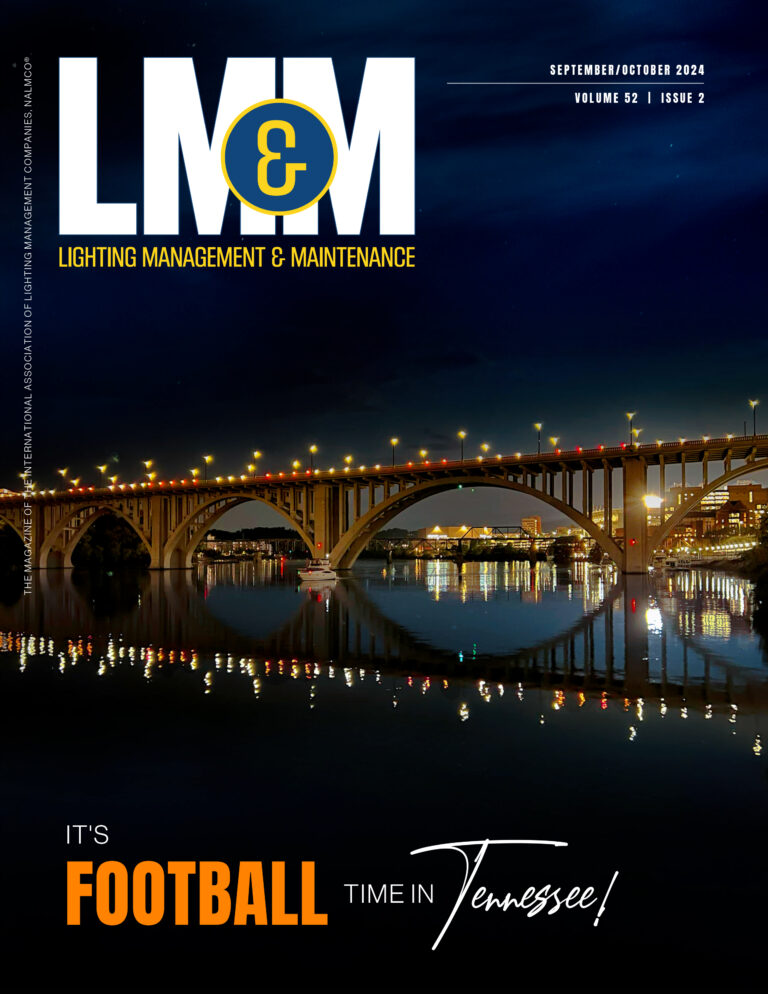New York, NY – The New York City Section of the Illuminating Engineering Society (IESNYC) is delighted to announce the esteemed recipients of the 2023 Lumen Awards, which were presented at the illustrious 55th Lumen Gala held on June 15, 2023, at Pier 60 in Chelsea Piers. The Lumen Awards and Gala, a distinguished program of the IESNYC, is a platform that highlights and celebrates excellence in lighting design.
“The Lumen Awards once again acknowledge talented individuals who, across generations, bring inspired projects to life,” said Lumen Committee Co-Chairs Clara Powell (Cooledge Lighting) and Adrienne Shulman (ERCO Lighting). “Lumen-winning projects drive the state of the art in lighting design excellence. They consistently demonstrate the best of what lighting design can do for architecture and placemaking, while raising the profile of the lighting industry as a whole.”
This year, a total of 14 lighting design firms were recognized with Lumen Awards for their exceptional projects. The award-winning projects were evaluated in three distinct categories: The Lumen Award of Excellence, the highest level of recognition for permanent architectural application; the Lumen Award of Merit, which honors meritorious permanent architectural applications; and the Lumen Citation, bestowed upon exceptional art installations, technical details, portions of single projects, temporary installations, or other works.
The recipients of the 2023 Lumen Awards are as follows:
Category: Awards of Excellence
- Linnaea Tillett Lighting Design Associates for the Morgan Library & Museum Garden
- One Lux Studio for 320 South Canal
- L’Observatoire International for the Tin Building by Jean-Georges
Category: Merit Awards
- LOOP Lighting for the Bus Terminal Tokyo Yaesu
- Focus Lighting for Chasing Rabbits
- Lighting Workshop for PENN 1
- Dot Dash for the POST Houston
- Melanie Freundlich Lighting Design for the Trinity Church Wall Street
Category: Citation Awards
- Renfro Design Group for the Museum of Contemporary Art San Diego
- Flux Studio Ltd for the Signal Station North
- BOLD LLC for the Journey to Edge/Peak
- Jen Lewin Studio for the Last Ocean
- Anita Jorgensen Lighting Design for the Silver Vault Gallery, Wadsworth Atheneum Museum of Art
- Kugler Ning Lighting for the Willis Tower Repositioning
The 2023 Lumen Award Jury, composed of esteemed professionals in the lighting industry, meticulously reviewed over 75 submissions. The jury members were Darina Zlateva (Director at KPF), Brian Smith (Director of Lighting at Icrave), Ashley Moench (Principal at Kugler Ning), Joshua Spitzig (Associate at Atelier Ten), Nathalie Rozot (Founder PhoScope), Gabe Guilliams (Principal at Buro Happold), and Al Uszynski (Editor and Publisher at Inside Lighting).
“The Lumen Awards program is a spirited, competitive, and challenging endeavor, culminating in the energetic and joyful Lumen Gala. Congratulations to the Lumen Award recipients honored for their outstanding achievements in lighting design,” said President of the IESNYC Megan Carroll (Lighting Services Inc). “The Lumens celebrate the entire community of lighting professionals. Architects, lighting designers, sales representatives, optical wizards, custom fabricators, distributors, and manufacturers come together, as one project team — bringing a vision of light to life.
Awards of Excellence

The Morgan Library & Museum Garden
New York, NY
Linnaea Tillett Lighting Design Associates
Linnaea Tillett, Janet Garwood, Chadwick Carswell, Jeanne Choi, and Khwanrudee Samranvedhya
ARCHITECTS
Beyer Blinder Belle Architects & Planners LLP
Frank J. Prial, Jr. and Jean Campbell
New exterior lighting is a key feature of the restoration of J.P. Morgan’s library, the historic heart of the Morgan Library & Museum in Midtown Manhattan. The lighting design creates a visual oasis on the teeming street. Inspired by the Greco-Roman notion of “drawing down the moon,” the design weds the magic of “moonlight” with the warm glow of “incandescence.”
Moonlight is provided by blue gel and 4000K fixtures cantilevered through the parapet’s balusters. The loggia is lit in 2700K, and features of the new garden are highlighted in 3000K. The Renaissance-inspired garden design includes various blue-toned pavers and pebbled mosaics at the ground plane, and the moonlight effect accentuates these. The design also brings some of the Morgan’s antiquities to light for the first time. Key features are highlighted to dramatize their sculptural character, and the interplay of color temperatures creates a visual dialogue.
The Morgan Library, designed by Charles Follen McKim and completed 1906, is one of the finest examples of Neoclassical architecture in the US. Landscape designer Todd Longstaffe-Gowan and Linnaea Tillett Lighting Design Associates have opened the library’s grounds for nighttime enjoyment, for the first time in the institution’s history.
“The winning project demonstrates a masterful use of light to create a compelling and harmonious experience both outside and inside. Rather than overwhelming the façade with light, the designers showed great restraint and focus in their approach, carefully selecting the elements they wanted to highlight and emphasizing them with precision. This approach shows a remarkable sensitivity towards the architecture, avoiding the common pitfall of over-lighting and preserving the beauty of the space.” – Joshua Spitzig, 2023 Lumen Awards Jury
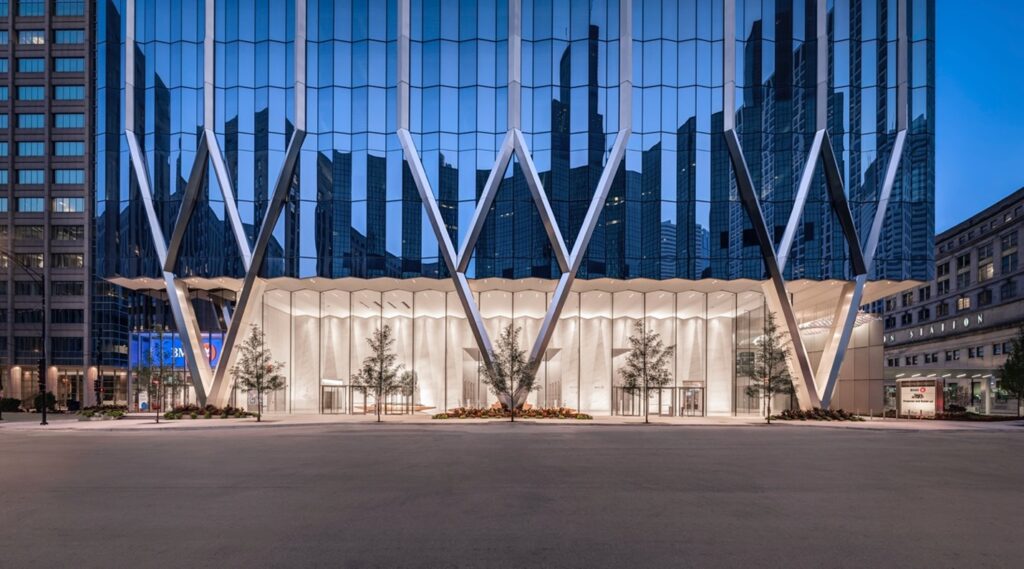
320 South Canal
Chicago, IL
One Lux Studio
Stephen Margulies, Yasamin Shahamiri, Taki Taniguchi, and SoHyung Bahng
ARCHITECTS
Goettsch Partners
Located directly south of the 1925 Union Station building, 320 South Canal is a new, 50-story landmark office tower that provides a striking addition to the Chicago cityscape, with over 1.5 million sqft of space.
Lighting at the lobby serves to emphasize the space’s unique architectural details, such as its featured faceted walls and ceilings. Clusters of three LED downlights integrate into the faceted ceiling, with sources at each bay illuminating the segmented core wall and glass wall wrapper. The fixtures were pre-aimed during manufacturing to ensure a clean look and minimize aiming time. To balance daylight, One Lux Studio sourced tunable LEDs and advocated for a zero-reflection glass façade, allowing unobstructed views for passersby.
Outside, the tower’s 1.5 acre greenspace – the largest privately owned park in the city – is open until midnight. The space is organized around a large, oval lawn and curved path, beautifully illuminated using linear lighting integrated beneath bench seating and bullets uplighting trees. Narrow-beam spotlights, concealed 300 ft up the building’s façade, aim down at the park, lending a moonlighting effect. Other architectural elements, like faceted columns at the façade, are illuminated to create a beautiful backdrop to the park.
“I was impressed by the way the lighting design for this project achieved such a striking and minimalist look, while still enhancing the visual impact of the building’s triangular stone structure. The pre-aimed lights and the sense of the building ‘floating’ were particularly successful. Overall, I find this project to be a remarkable achievement in lighting design.” – Brian Smith, 2023 Lumen Awards Jury
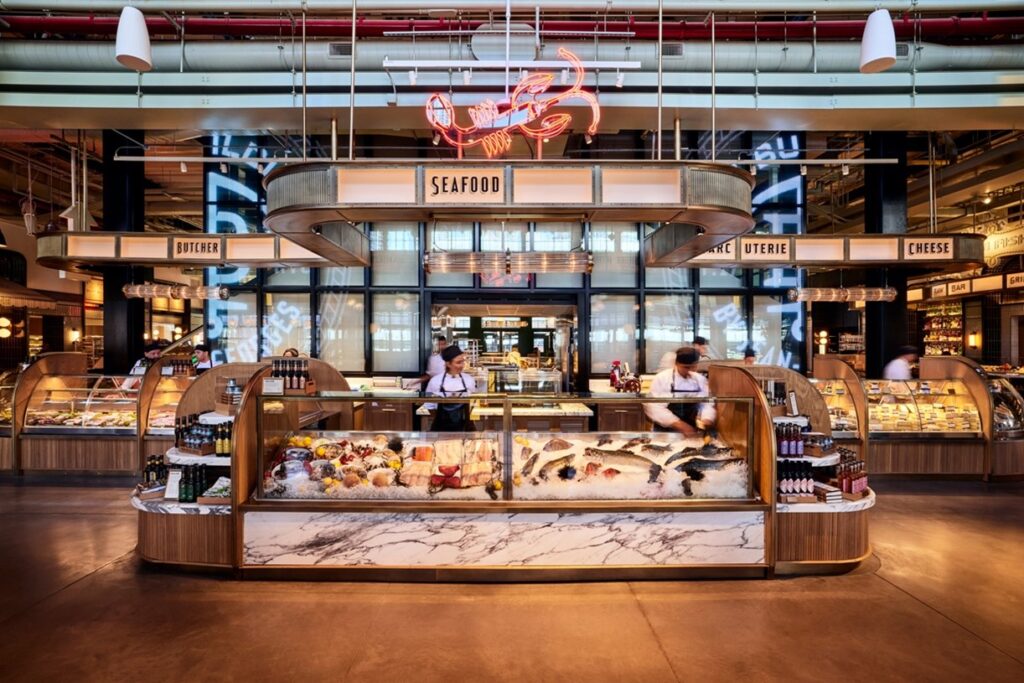
Tin Building by Jean-Georges
New York, NY
L’Observatoire International
Hervé Descottes, Carlos Garcia, and Esteban Varas
ARCHITECTS
Roman and Williams
Cass Calder Smith
In an exciting collaboration with interior designer Roman and Williams and restaurateur Jean-Georges Vongerichten, L’Observatoire International lighted the entire 64,000 sqft of the historic Tin Building, the original home of the Fulton Fish Market. The 1907 building was disassembled and replicated at Manhattan’s South Street Seaport, creating a bustling destination. A leitmotif of historically flavored luminaires connects us to the past. And the numerous markets, bars, and restaurants contain individualized articulations of a unified lighting design vocabulary.
The core of the first-floor market is activated by integrated lighting in the millwork and tunable-white backlighting of art glass panels. Pockets of design create self-contained experiences, and custom luminaires help define the unique destinations. Highly customized “invader” luminaires might feel familiar but use divergent expressions.
In the upstairs market, linear lighting in every product shelf is supported by track lighting and accented by custom decorative fixtures. The high-end Asian restaurant greets visitors with distinctive, red-tiled shelving exaggerated by red strip lighting at the back and then white front light on products.
Day and night, this waterfront landmark pulses with new life. The lighting ensures that shoppers and diners engage with the venue’s overall identity, easily navigate the enormous floorplan, and delight in unique, multisensory dining experiences.
“Despite the ample lighting throughout each space, the team’s expert layering of light creates a nuanced and sophisticated ambiance. I was particularly impressed by the lack of any visible light sources, resulting in a beautiful aesthetic. The team’s use of color rendering ensures that each object is able to stand on its own, contributing to the stunning visual display. The level of technical skill demonstrated in this project is truly astounding.” – Ashley Moench, 2023 Lumen Awards Jury
Awards of Merit

Bus Terminal Tokyo Yaesu
Tokyo, Japan
LOOP Lighting
Ryoko Nakamura, Ruben Gonzalez, and Kaori Hiroki
NIHON SEKKEI
Yoshiko Nakayama
ARCHITECTS
NIHON SEKKEI, INC.
TAKENAKA CORPORATION
Bus Terminal Tokyo Yaesu, the largest bus terminal in Japan, has opened in front of Tokyo Station. The overall goal was to elevate terminal spaces in Japan, as most are purely utilitarian in design and lacking in spatial awareness. This careful collaboration between architecture and lighting says, We can do better.
The spatial form of the bus terminal is a one-room space where movement and stillness coexist. Vertical planes of illumination enhance the perception of brightness and welcome in this underground space. Wayfinding is clear and pleasant while preserving visual interest and a sense of exploration. A line of white light on the dark ceiling creates the “racetrack” that pulls you along the route while attenuating the space – a moment of speed.
Curved extrusions of white coves create “Floating Clouds on a Dark Sky”: a threshold moment. A lounge area features cove lighting and downlighting to define a moment of repose. Fast and slow coexist while being distinct spaces. The spatial design goal provides a visual guide for each activity and cues visitors as they transition through the terminal. The juxtaposing volumes of speed and stillness carved through light create a comfortable environment for lingering and waiting.
“The winning project is a shining example of how expert lighting design can transform even the most mundane public spaces into beautiful and inviting environments. In this case, the innovative use of clean lines of light in a busy bus terminal has created a space that is not only tolerable, but pleasant to be in. The lighting design effectively combats the dirt and fumes typically associated with bus terminals, creating a bright and clean atmosphere that is truly transformative.” – Al Uszynski, 2023 Lumen Awards Jury
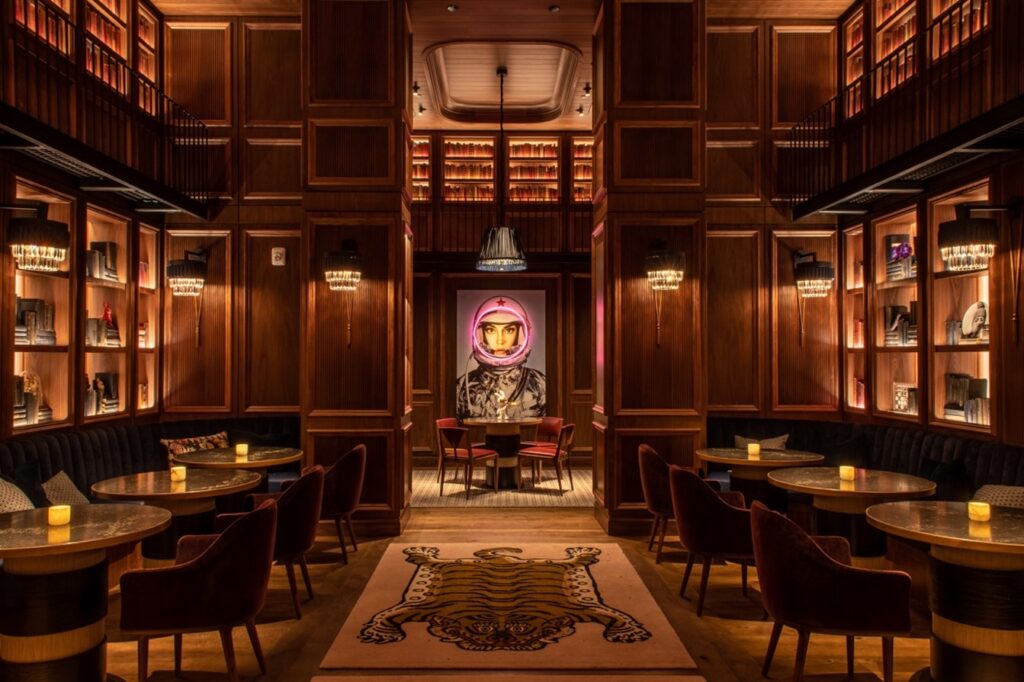
Chasing Rabbits
Vail, CO
Focus Lighting
Valentina Doro, Juan Pablo Lira, Erin Ryan, Zoe Neijna, Kenny Schutz, and David Bull
ARCHITECTS
Davis Partnership
Rockwell Group
Immersed in a 10,000 sqft clubhouse, guests travel on a fantastic journey, “chasing rabbits” from room to room. The lighting design celebrates playfulness and relaxed sophistication.
At the entry, Edison bulbs suspended above a raspberry, transmissive ceiling dazzle, while backlit etched mirror panels add to the balanced infinity effect. In another corridor, etched graphics within reflective panels are backlit with cool LED panels. The colorful sculpture at the end is modeled by both track accents and discreet uplights.
In contrast, interior spaces are bathed in multilayered warm lighting. In the restaurant, light grazes up and down along the perimeter, creating a soft glow behind the dark framing treatment. Custom snoots ensure dramatic, super-tight accents on the tables. In the library, each shelf has a linear frontlight and a softer glow behind, so the entire room exudes inviting warmth. Decorative fixtures reinforce the human scale, while the neon art piece sizzles. The speakeasy feels mysterious with delicate layers of lighting bringing beautiful patterns and finishes to life.
In the arcade, the cinema-inspired bar is backlit, while gaming areas create excitement. This juxtaposition of classic and eccentric encapsulates the concept of this project: a refined lighting design injected with surprising, entertaining moments.
“The winning project demonstrates the incredible power of lighting to transform a space and create a truly memorable experience. The team’s use of lighting in each space is carefully tailored to its unique character, resulting in a whimsical and captivating journey through the design. The project’s entrance is particularly striking, setting the stage for the remarkable experience that awaits inside.” – Ashley Moench, 2023 Lumen Awards Jury

PENN 1
New York, NY
Lighting Workshop
Doug Russell, Megan Casey, and Kim Dai
ARCHITECT
Architecture + Information (A+I)
Located above bustling Penn Station within the revitalized Penn District, this 150,000 sqft building amenity hub gives us a glimpse into the future of workplace design. The three-floor project creates an ecosystem of spaces for work, wellness, and socialization. Lighting serves the programmatic and design needs of each space, emphasizing rich textures and their transitions.
The dramatic, double-height lobby pairs concealed linear wall-grazers on textured, hewn stone walls with soft ambient coves and discreet recessed downlighting onto the highly reflective floor. Interactive digital-screen risers invite visitors to climb the grand stair, which contrasts large video screens against the dark finish palette.
At the conference center, a large, luminous ceiling of LED panels above stretched fabric and acoustic baffles produces a glowing effect that is both diffuse and textured. Dramatic contrasts center the experience center. Tightly focused track lighting accents the cityscape model, while toe-kick lighting defines seating.
In several spaces, mirrored ceilings and wall panels play with angles or sparkle with reflections from warm decorative fixtures and artwork. The bar features a strong, linear chandelier suspended below an uplit gold ceiling.
The fitness center’s staircase features shimmering art walls. Quiet, multicell downlights tucked between panels avoid unwanted reflections.
“The way that the lighting seamlessly integrates with the materials and architecture is really impressive. It adds a level of complexity and detail that really elevates the space. This project stands out as a great example of how to create a unique and striking commercial interior space. The lighting plays a significant role in achieving this, seamlessly integrating with the design and adding a layer of sophistication.” – Brian Smith, 2023 Lumen Awards Jury

POST Houston
Houston, TX
Dot Dash
Christopher Cheap, Marcelline Lacombe, Chen Chen, Marta Casarin, and Isabel Sanchez Sevillano
ARCHITECTS
OMA
Jason Long and Salome Nikuradze
POST Houston is an adaptive reuse of a long-abandoned Postal Service headquarters into a dynamic, mixed-use complex. The lighting design is integrated within the architectural interventions and intentionally independent from the original building.
Atriums were created within the cavernous space, each featuring a unique, monumental staircase with integral lighting components. A double-helix stair is the sculptural focal point of the “O” Atrium, with lighting incorporated into the mesh guardrail. Market Hall canopies delineate each kiosk and provide soft, intimate light for diners.
The “X” stair can transform into a stage using DMX-controlled theatrical framing projectors mounted to roof beams. At the Live Nation venue’s Lobby Bar, the lighting design is inspired by concert blinder lights. To create dramatic portals to accessory spaces, lighting glows within a translucent polycarbonate wall. At the stair, striplighting reveals the movement of guests. Once inside, dimmable blue grazers between open-cell guardrails highlight the balcony geometry.
Accessed by these monumental stairs, a 5 acre rooftop park includes distinctive landscape and lighting environments, punctuated by the soft glow of ring lights within the 40 walkable skylights. Overall, the lighting design preserves the existing building while celebrating new additions, creating a hub for culture, dining, work, art, and recreation.
“The winning project is remarkable for its innovative use of color to create unexpected emotional connections in each unique space. I was struck by the project’s departure from the standard approach, utilizing color in a bold and surprising way to create a truly original experience. Overall, this project stands out for its creativity, originality, and thoughtful use of lighting to create a genuinely memorable experience.” – Darina Zlateva, 2023 Lumen Awards Jury

Trinity Church Wall Street
New York, NY
Melanie Freundlich Lighting Design
Melanie Freundlich and Michael Peace
ARCHITECTS
MBB Architects
Jeff Murphy and Zach Poole
The layered lighting design of the landmarked Trinity Church Wall Street highlights the beauty of the materials and interior architecture, and provides state-of-the-art lighting technology, seamlessly integrated into the 1848 interior. This multi-phase rejuvenation and restoration included a complete redesign of the architectural lighting for every interior and exterior space. Aimed primarily at enhancing both live and virtual worship experiences, challenges included resolving long-standing light level and glare issues for both attendees and clergy.
The sequential experience of arrival begins with the dramatic vestibules and narthex, where bronze sconces and concealed accent lights graze the original carved wood paneling and uplight the gilt ceiling. Entering the nave, the view opens to reveal the restored vaulted ceiling. A family of historically appropriate custom lanterns was fitted with multiple up and down sources to uplight the ceiling and provide soft wall illumination. Larger pendants align with the columns in the nave, and a scaled-down version illuminates the side aisle pews and ceiling, which were previously unlit. Concealed linear and curved lighting accentuate architectural features throughout the nave and chancel. They are mounted to the clerestory sills and concealed behind the historic Astor Reredos to dramatically illuminate statuary, tracery, and gold-leaf detailing.
“This project has been executed with exceptional attention to detail, resulting in a stunning composition that truly defines the space. Having personally experienced it, I must also highlight the mesmerizing beauty of the stained glass when viewed from the outside. While not shown here, it’s a further testament to the skillful execution of this project.” – Gabe Guilliams, 2023 Lumen Awards Jury
Citation Awards

CITATION for Integration of Daylight and Electric Light
Museum of Contemporary Art San Diego
La Jolla, CA
Renfro Design Group
Richard Renfro, Sarah Randall, Silvia Mazzarri, and Fabio Tuchiya
ARCHITECTS
Selldorf Architects
Annabelle Selldorf, Sara Lopergolo, Ryoji Karube, and Wanda Willmore
Originally an oceanfront residence completed a century ago, this West Coast museum sits atop a steep bluff overlooking the ocean. To find inspiration, the design team looked no farther than the breathtaking views and abundant sunshine.
The project scope added 46,000 sqft of new gallery and event spaces and renovated 28,000 sqft of existing galleries. Unifying old and new, the design team created a cohesive lit environment that harmoniously blends controlled natural daylight with state-of-the-art electric light for a holistic, energy-efficient art lighting solution.
A new glass entrance and playful bookstore welcome visitors. Inside the soaring gallery spaces, daylight apertures were expertly sculpted to harness sunlight in a controlled manner respectful of the art and curatorial requirements. Baffles diffuse direct sunlight for a full-spectrum light source that changes subtly without distracting hot spots.
At the central gallery, translucent ceiling panels backlit by color-tunable sources help balance the room, while the integrated track system highlights artwork. As the building opens at the back, shaded windows frame phenomenal ocean views towards the northwest. Simulations for various sky conditions informed both the daylighting design and supplemental electric lighting; producing a serene museum environment that retains a physical sense of surrounding sea and sky.
“What stands out most to me about this project is the skillful handling of daylight. Working with natural light in a museum setting requires a heightened level of attention and precision, and the way the vertical apertures and light sources have been carefully calibrated is impressive. Equally remarkable is the designers’ ability to strike a balance between natural and artificial light, which enhances and elevates the beauty of the art and architecture.” – Gabe Guilliams, 2023 Lumen Awards Jury

CITATION for Community Lighting Initiative
Signal Station North
Baltimore, MD
Flux Studio Ltd
Glenn Shrum, Laura Dillon, and Paloma Sherman
ARCHITECTS
PI.KL Studio
Kuo-Pao Lian and Brian Baksa
To address current and historical inequities in urban lighting, we need to move beyond layouts and fixture selections toward more holistic and dynamic solutions. This public space lighting initiative questions those typical lighting design processes and outcomes, exploring how the lighting in an urban district could better support its residents.
The interdisciplinary team organized multiple social events and information-gathering sessions to improve our understanding of what the community valued in urban lighting. Informed by research, Flux Studio assembled resources, including a Lighting Plan that analyzed existing conditions, focusing on the pedestrian experience. The plan also outlined an open framework with a range of lighting interventions. This gave the community agency to identify solutions that maintain cohesion across the district.
A Lighting Guidebook provided accessible educational material with basic technical knowledge about light. And the Community Lighting Guide contained infographics on how to report outages and navigate the bureaucracy that governs the city’s lighting infrastructure.
This open-source information is intended to empower members of the Station North community to advocate for their interests on lighting-related issues from a more informed perspective. These resources can also assist those who understand what good lighting can offer, in efforts to share that understanding and power.
“This award-winning initiative demonstrates a thoughtful process of community engagement with design workshops, curated light-based public art installations in public spaces and a lighting masterplan. By educating the community about lighting and optimizing the positive impact of lighting in public space, it serves as a great model for using lighting in creative placemaking.” – Nathalie Rozot, 2023 Lumen Awards Jury

CITATION for an Immersive Environment
The Journey to Edge/Peak
New York, NY
BOLD LLC
Gary Wong, Mai Shimizu, Brian Orter, Alyssa Ayow,, Bradley Clements, and Charlie Dumais
ARCHITECT
Rockwell Group
Located at 30 Hudson Yards, this 101-floor journey to The Edge features everything from a brass-trimmed, 45-seat bar area to an innovative, sustainability-focused exhibit.
The multi-sensory experience begins on floors 4 and 5, where visitors enter a hallway of water-filled caissons designed to mirror the building’s foundation and unique engineering approach. Next, a floor-to-ceiling digital representation of the Hudson Rail Yard engulfs the hallway as visitors continue towards the elevators. The historical display is exhibited with an avant-garde glimmer, which illuminates through speck-like openings in the bronze scaffolding. Color-changing strips balance the cooling light-blue outlines of digital subway cars.
In the elevator-queue area, a blue perimeter cove blends seamlessly with the overhead displays and side panels, accentuating the warm hues to create the perfect observation environment.
At the close of the exhibition, the design transitions from the captivating displays to a high-end lounge and dining experience. A balance of warm lighting, natural oak-wrapped ceilings, and champagne metal polishes produces a soulfully robust tone, which enables a fluid transition to the 96-floor journey to unparalleled city views and dining.
At the pinnacle, a harmonious balance of natural and electric lighting heightens the ambiance surrounding one of New York’s most breathtaking experiences.
“This award-winning project remarkably exhibits the power of lighting to define space: its lighting features are intentionally designed and carefully crafted to truly differentiate each sequential area with a unique character.” – Nathalie Rozot, 2023 Lumen Awards Jury
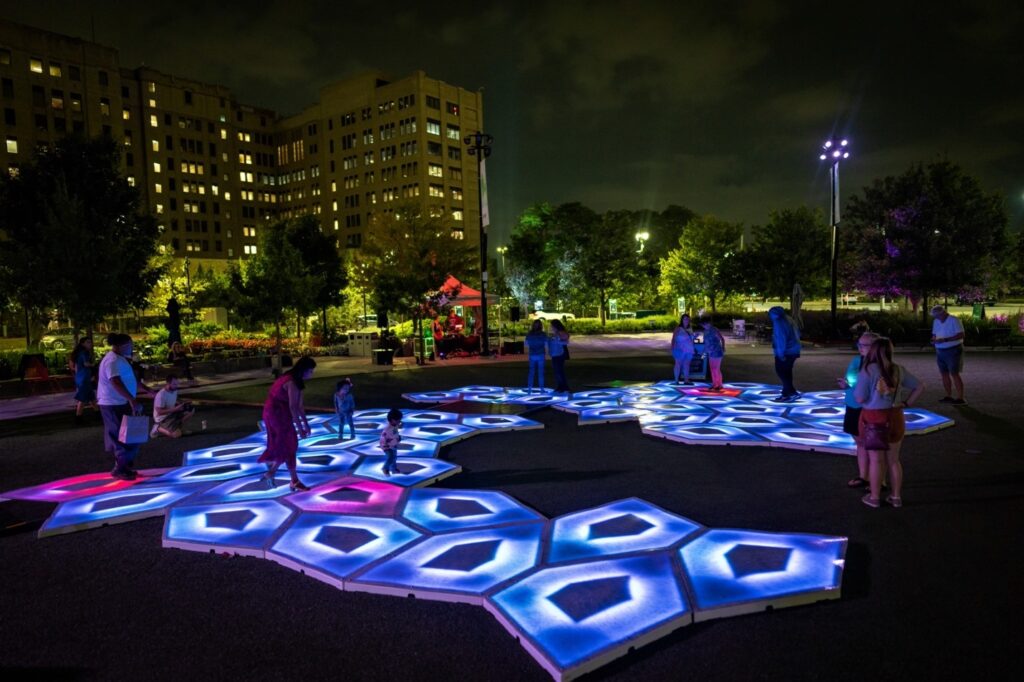
CITATION for Environmental Awareness Through Light
The Last Ocean
Brooklyn, NY
Jen Lewin Studio
Jen Lewin and Mikael Flores-Amper
Jen Lewin’s interactive art installation, The Last Ocean, sheds light on the crisis of plastic pollution in our oceans, the warming planet, dwindling natural resources, and the need for systemic change.
Built by hand in the artist’s Brooklyn studio, the installation features expansive interactive platforms illuminated by community engagement and made from reclaimed ocean plastic. The geometric tessellations form the glacial body of Antarctica, creating a luminescent ice field full of wonder and awe.
Iterations of The Last Ocean installation have transformed public spaces from Sydney to Detroit. Three hundred interactive platforms, at 8000 sqft, comprise hundreds of thousands of LEDs controlled by the artist’s proprietary mesh network technology. As the installation takes shape, it offers a dynamic and evolving experience for those who engage with it.
During the day, the platforms display the transformation of the reclaimed ocean plastic with swirls of blue and white particulates. At night, the installation comes alive with vibrant oscillations that react to the movement of the participants as they splash and dance in the waves of light. The Last Ocean offers a powerful display of the beauty and magnificence of our oceans and reminds us of the need to actively protect them.
“To me, what makes this project really special is that it uses light as a way to activate public spaces while also promoting awareness about climate change. The project brings people together in a way that just wouldn’t be as effective without the lighting element. Then it conveys an important message about sustainability to the people that it gathers. The versatility and efficiency of this concept is commendable.” – Joshua Spitzig, 2023 Lumen Awards Jury
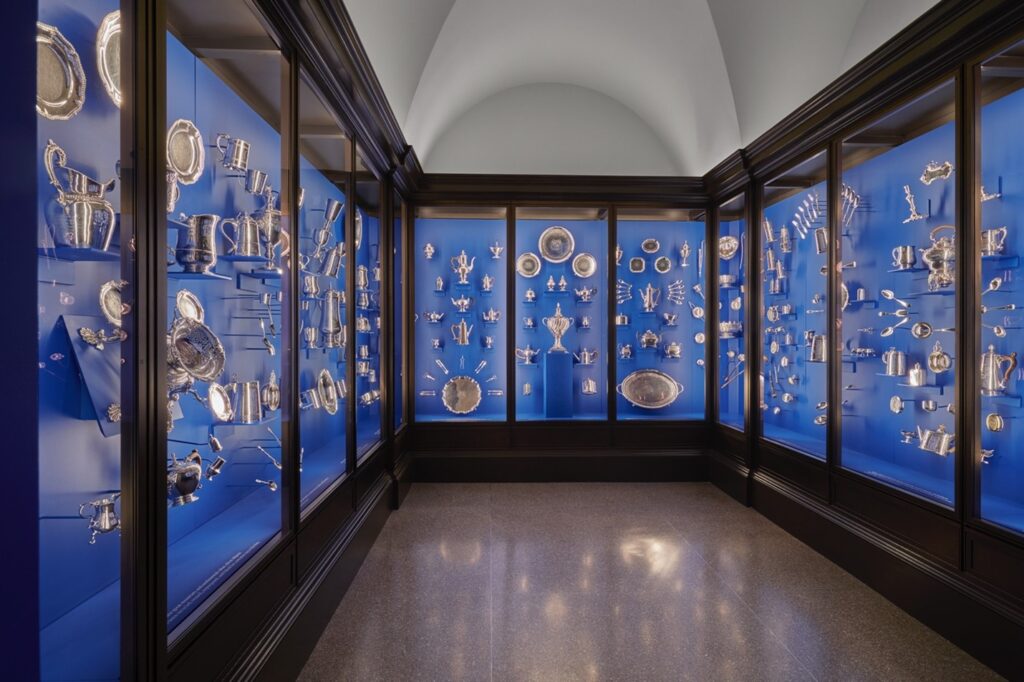
CITATION for Artifact Illumination
The Silver Vault Gallery, Wadsworth Atheneum Museum of Art
Hartford, CT
Anita Jorgensen Lighting Design
Anita Jorgensen, Joe Ballweg, and Katherine Lindsay
ARCHITECT
Steven W. Spandle Architect LLC
Steven W. Spandle
The hands-on design process for this sparkling gallery began with an initial testing and mockup phase. Starting above the display cases, concealed linear LED luminaires brush softly across the vaulted ceiling. The carefully balanced, reflected light provides gentle ambient illumination for visitors.
Continuous linear luminaires concealed within the display cases highlight the silver objects with velvety lines of light at 3000K and 97+ CRI. Special optical lenses produce gentle ribbons of light along the contours of the silver objects. Shadows in the hollow forms fill with cool light reflected off the royal blue interior finish of the casework. This subtle shift from clean, neutral white highlights to cool fill light enhances the perception of form for each unique object.
Just a touch of light brings the silver objects to life, while also providing sufficient horizontal illumination for the interactive, pull-out drawer displays. Each case module, as well as each indirect ceiling component, is individually controlled. This allows for subtle fine-tuning of the lighting levels to create a stunning, yet comfortable, unified whole.
The success of this seemingly effortless installation is largely due to the collaborative nature of the project’s design process: from concept to mock-up to final balancing.
“I was particularly captivated by the beauty of the vitrines in this project. Despite being a small component in an exhibition room, the lighting design was so beautifully executed that it made me feel something really powerful. This is a testament to the power of lighting to highlight and elevate important moments, which this project deserves recognition for.” – Darina Zlateva, 2023 Lumen Awards Jury

CITATION for Entry and Lobby Lighting
Willis Tower Repositioning
Chicago, IL
Kugler Ning Lighting
Ashley Moench, Burr Rutledge, Jerry Kugler, Meryl Sell, Eric Benne, and Jackson Ning II
ARCHITECT
Gensler
Designed in the 1970s and once world-famous as the Sears Tower, the Willis Tower entrances were imposing and unwelcoming for today’s active urban streetscapes. The entire base of the skyscraper was reimagined to emphasize visibility, transparency, and comfort.
Uplighting a 75 ft–wide terracotta portal frames the new “jewel-box” entrance at Wacker Avenue. In-grade uplighting of the striated terra cotta walls extends into the skylit lobby. Uplighting the white ceiling of the crossing bridge helps ease contrast with the bright outdoor views, and brightens the space on cloudy and rainy days.
Dramatically backlit stair risers ascend through the tower’s exposed structure. Mirror-like reflections from the glass guardrails magnify the visual impact.
The tower’s columns and beams are silhouetted by grazing the original lobby’s travertine core wall, which also creates a dramatic backdrop for a new hanging sculpture. Working closely with local artist Jacob Hashimoto, spotlights are aimed to enhance the depth and texture of thousands of paper-and-resin discs.
The layered lighting design improves visual connections from the streetscape and welcomes tenants and visitors to gather and socialize. All while celebrating the tower’s original glass and metal aesthetic, an iconic feature of Chicago’s industrial heritage.
About the IESNYC
IESNYC (www.iesnyc.org) is the New York City Section of the Illuminating Engineering Society. The IESNYC is a volunteer professional membership organization whose members share a mutual appreciation for and fascination with all things lighting. They are lighting designers, architects, engineers, consultants, lighting manufacturers, lighting representatives, electrical distributors, and allied professionals. IESNYC members are dedicated to promoting the art and science of illumination engineering to their members, professionals, the lighting industry, and the public through inspiring events, informative programs and educational series, social outreach, and networking opportunities.

